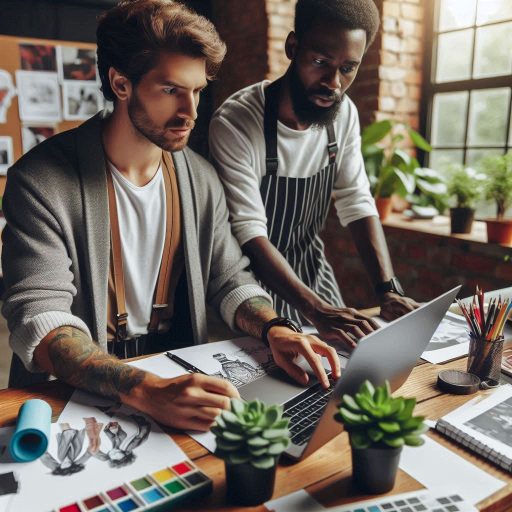Introduction
Exhibition design combines art and functionality to create engaging experiences.
It plays a crucial role in how visitors interact with displays.
A well-designed exhibition attracts attention and encourages exploration.
Great exhibition design captures the audience’s imagination, drawing them in to discover more.
Effective design communicates messages clearly and effectively.
It guides visitors through a narrative, enhancing their understanding of the subject matter.
By using space, color, and light strategically, designers create immersive environments that leave lasting impressions.
Thoughtful layout and flow ensure visitors can navigate easily and comfortably.
Moreover, great exhibition design reflects the values and goals of the exhibitor.
It showcases products, ideas, or concepts in a way that resonates with the target audience.
Successful exhibitions not only inform but also inspire action, fostering connections between visitors and the content.
In today’s competitive landscape, standing out is essential.
A captivating exhibition design sets a brand apart, making it memorable.
Overall, great exhibition design is vital for attracting visitors and effectively conveying messages.
It transforms spaces into engaging experiences that educate and inspire.
Clear Theme and Purpose
Establishing a clear theme and purpose is essential in exhibition design.
A well-defined theme acts as the foundation of the entire exhibit.
It communicates the core message to attendees and guides their experience.
The Key Theme or Message of the Exhibition
Begin by defining the key theme or message of the exhibition.
Consider the goals you want to achieve.
Ask yourself what you want the audience to learn or feel.
This clarity will shape the exhibition’s narrative.
Once you define the theme, ensure that every design element aligns with it.
This includes graphics, colors, and layout.
Each component must reinforce the central message.
For instance, if the theme is sustainability, use eco-friendly materials and designs.
Choose colors and images that evoke a sense of nature and responsibility.
This visual consistency creates a cohesive experience for attendees.
Elements of Design Work Together to Convey the Theme Effectively
Incorporate storytelling into your exhibition.
Use your theme to create a narrative that guides visitors through the space.
Arrange displays in a way that flows logically from one section to another.
Use signage effectively to explain the theme and its significance.
Make sure visitors can easily understand how each exhibit ties back to the overall message.
Consider the audience when developing the theme.
Tailor your message to resonate with them.
This connection will engage visitors more deeply and encourage interaction.
Use language and visuals that are relatable to your target demographic.
Knowing your audience allows you to craft an experience that feels relevant and impactful.
Interactivity is another vital element of conveying your theme.
Engage attendees with hands-on experiences that illustrate your message.
Incorporate technology, such as augmented reality, to enhance understanding.
This immersive approach helps visitors grasp complex concepts related to your theme.
It fosters a memorable experience that leaves a lasting impression.
Evaluate the layout of the exhibition space.
Ensure that the flow guides visitors smoothly through the exhibits.
Use spatial arrangement to emphasize key elements related to the theme.
Create focal points that draw attention to significant displays.
This strategic placement enhances comprehension of the theme.
Finally, solicit feedback from a sample audience before the exhibition opens.
This input can reveal whether your theme is effectively communicated.
Adjust any elements that may not align with your intended message.
Continuous improvement ensures that the exhibition resonates with visitors.
In review, a clear theme and purpose are foundational to great exhibition design.
Define your message, ensure consistency, and create an engaging narrative.
Use interactivity and thoughtful layout to reinforce your theme.
By focusing on these key elements, you will create a memorable experience that leaves a lasting impact.
Read: Best Tools and Software for Character Designers
Engaging Layout
An engaging layout is essential for successful exhibition design.
It shapes how visitors interact with your displays.
First, consider the flow of traffic.
You want to guide visitors through the space smoothly.
Start with an open entrance that invites exploration.
Avoid cluttered areas that can confuse or overwhelm.
Consider the Flow of Traffic
Think about the positioning of key exhibits.
Place high-interest items at eye level to draw attention.
Use sightlines effectively to create visual paths.
This approach encourages visitors to explore every corner of the exhibition.
Designate specific routes to guide traffic and prevent congestion.
Signage can help direct visitors and enhance their experience.
Create Areas for Interaction and Engagement
Creating distinct zones within the exhibition adds depth.
Each zone can serve a unique purpose.
For instance, incorporate an interactive area to promote engagement.
This space should encourage visitors to touch, explore, and participate.
Interactive exhibits enhance understanding and create memorable experiences.
Incorporate comfortable seating areas where visitors can take breaks.
These areas allow people to reflect on what they have seen.
They also provide a space for informal discussions.
Make sure these spots are strategically placed near major exhibits.
This arrangement keeps visitors engaged while offering respite.
Consider the sensory experience of your layout.
Use colors, textures, and lighting to create a mood.
Bright colors can energize a space, while softer hues can promote relaxation.
Effective lighting can highlight important elements and create ambiance.
Use these tools to enhance the overall experience for visitors.
Integrate technology into your layout to further boost engagement.
Digital displays can offer interactive elements that inform and captivate.
Virtual reality experiences allow visitors to immerse themselves in your exhibition.
Technology can also streamline navigation, helping visitors find their way.
Incorporating areas for social interaction can foster connections.
Create zones where visitors can gather, share ideas, and discuss what they‘ve learned.
This interaction enriches the overall experience and encourages community building.
Incorporating interactive workshops or demonstrations can also draw visitors in.
These activities provide hands-on opportunities that captivate attention.
Lastly, gather feedback on the layout to improve future exhibitions.
Encourage visitors to share their experiences and suggestions.
Use this information to refine your design.
This approach not only enhances visitor satisfaction but also boosts the overall effectiveness of your exhibition.
In essence, an engaging layout is critical for exhibition success.
By considering traffic flow, creating interactive zones, and integrating technology, you enhance visitor experiences.
Make every area count and ensure that your exhibition is memorable and impactful.
Read: Ceramic Art: From Hobby to Professional Career
Strategic Use of Lighting
Lighting is a vital component of exhibition design.
It can transform an ordinary space into an engaging experience.
Strategic use of lighting highlights key elements and sets the ambiance.
Thoughtful illumination guides visitors‘ attention, ensuring they notice significant pieces.
Utilize Lighting to Highlight Key Elements and Create Ambiance
Utilizing various lighting techniques can enhance the overall exhibition impact.
For instance, spotlighting specific artifacts draws immediate attention.
This technique directs focus to important items while enhancing their features.
Track lighting provides flexibility, allowing adjustments throughout the exhibition duration.
This adaptability enables curators to emphasize different pieces as needed.
Creating ambiance is another critical aspect of lighting.
Soft, warm lighting can evoke comfort and encourage exploration.
In contrast, cooler lighting may create a modern, sleek feel.
The color temperature significantly influences visitors’ emotions and perceptions.
It shapes their experience and interaction with the exhibit.
Adjust Lighting to Enhance Mood and Emphasize Important Pieces
Adjusting lighting according to the exhibition‘s theme is essential.
For example, historical displays may benefit from warmer, vintage tones.
In contrast, a contemporary exhibit may use brighter, cooler lighting.
Tailoring the lighting to match the narrative adds depth and context.
This alignment enhances the overall storytelling of the exhibition.
Lighting can also affect spatial perception.
Brightly lit areas can make spaces appear larger and more open.
Dim lighting in certain sections can create intimacy and focus.
This variation in lighting not only captivates visitors but also guides their journey.
By strategically planning lighting placements, designers can influence how attendees navigate the space.
Moreover, integrating lighting with other design elements enhances the exhibition’s cohesiveness.
Combining lighting with colors, textures, and materials creates a harmonious environment.
This synergy captivates audiences and fosters a memorable experience.
When all elements work together seamlessly, visitors feel more connected to the exhibit.
Incorporating dynamic lighting effects can further elevate the experience.
Movement and color changes keep the environment lively and engaging.
For example, using LED lighting to create shifting colors can reflect different themes or moods.
These innovative techniques encourage visitors to interact and linger longer.
It is crucial to consider the technical aspects of lighting design.
Collaborating with skilled lighting designers ensures the best outcomes.
They can provide insights into optimal placements and techniques for maximum impact.
Additionally, proper maintenance of lighting systems is essential.
Regular checks prevent technical issues that could detract from the experience.
In general, the strategic use of lighting plays a vital role in exhibition design.
By highlighting key elements and creating ambiance, lighting enhances the visitor experience.
Adjusting lighting to enhance mood emphasizes important pieces.
A well-planned lighting strategy transforms exhibitions into captivating environments that resonate with attendees.
Read: Ceramic Art Exhibitions to Visit in 2024
Attention to Detail in Exhibition Design
Focus on Small Details Such as Typography, Colors, and Spacing
Attention to detail is crucial for creating an impactful exhibition design.
Small elements, such as typography, colors, and spacing, can significantly influence audience perception.
Effective typography captures attention and conveys the right message.
Select fonts that align with the exhibition‘s theme and purpose.
Use a limited number of font styles to maintain clarity.
Ensure readability at varying distances by adjusting font sizes appropriately.
Colors evoke emotions and set the tone for the entire exhibition.
Choose a color palette that reflects the brand and resonates with the audience.
Consistency in color usage across different display elements enhances visual harmony.
It helps create a cohesive experience, guiding visitors through the exhibition.
Utilize color contrast to highlight important information and draw attention to key areas.
This technique ensures that critical messages stand out.
Spacing is another essential element of design.
Proper spacing between text, images, and other elements prevents overcrowding.
It allows visitors to absorb information without feeling overwhelmed.
Effective use of negative space creates a balanced layout that encourages exploration.
Ensure that each element has enough breathing room, allowing for clear visual pathways.
Consistency in Design Elements Throughout the Exhibition
Consistency is vital in maintaining a polished and professional appearance.
Design elements should align with the exhibition’s overall theme.
This includes typography, colors, graphics, and other visual components.
Establish design guidelines before the project begins to ensure everyone is on the same page.
Consistent design reinforces brand identity and helps build recognition among attendees.
In addition to the visual aspects, consider the layout of the exhibition space.
Ensure that the arrangement of booths and displays flows logically.
A well-planned layout guides visitors seamlessly from one area to the next.
Create focal points that draw attention and encourage interaction.
This not only enhances the visitor experience but also maximizes engagement with the content.
Lighting also plays a significant role in emphasizing design elements.
Use lighting strategically to highlight key displays and create an inviting atmosphere.
Proper lighting can enhance colors and make typography more legible.
Ensure that the lighting complements the overall design without causing distractions.
Finally, regularly review and revise your design elements.
Gather feedback from team members and potential attendees.
This collaborative approach helps identify areas for improvement and ensures that the design meets its objectives.
Paying close attention to detail allows designers to create exhibitions that leave a lasting impression.
A well-executed exhibition engages audiences and encourages meaningful connections with the content.
Attention to detail transforms an average exhibition into an extraordinary experience.
Read: Career Paths: Becoming a Professional Character Designer

Use of Technology in Exhibition Design
In today‘s exhibitions, technology plays a crucial role.
It enhances visitor experiences and creates memorable interactions.
Incorporating digital displays is essential for modern exhibits.
These displays can showcase information, images, and videos in a dynamic format.
They grab attention and keep visitors engaged.
Incorporate digital displays, interactive elements, or multimedia to enhance the visitor experience
Incorporate Digital Displays
Digital displays serve as a focal point in many exhibitions.
They can present real-time data or updates related to the exhibit.
Visitors appreciate interactive maps or schedules accessible through these displays.
This accessibility helps them navigate large exhibition spaces.
Additionally, vibrant visuals attract a wide range of visitors.
Engaging graphics enhance storytelling and reinforce key messages effectively.
Interactive Elements
Interactive elements significantly improve visitor engagement.
Touchscreens allow guests to explore content at their own pace.
They can access detailed information or participate in quizzes.
These activities encourage visitors to interact with the exhibits.
This interaction fosters a deeper understanding of the subject matter.
Games and challenges related to the exhibit theme also create excitement.
They motivate guests to learn while having fun.
Multimedia Presentations
Multimedia presentations can enhance exhibitions.
Combining sound, video, and visuals creates a rich narrative.
It captures visitors‘ attention and conveys messages effectively.
Using multimedia helps communicate complex ideas simply and engagingly.
This approach appeals to a broader audience, including different age groups and backgrounds.
Thoughtfully crafted narratives can guide visitors through the exhibit journey.
Transform Your Career Today
Unlock a personalized career strategy that drives real results. Get tailored advice and a roadmap designed just for you.
Start NowIntegrate technology seamlessly into the overall design
Seamless Integration
Seamless integration of technology is vital.
It ensures that tech elements enhance rather than overwhelm the exhibition.
Designers should consider the flow of the exhibition space.
Technology should complement physical displays, not distract from them.
A harmonious blend of digital and physical elements creates a cohesive experience.
Effective integration creates an inviting atmosphere for visitors to explore.
Lighting Considerations
Lighting plays a significant role in integrating technology.
Proper lighting can highlight digital displays and interactive elements.
It sets the mood and draws visitors‘ attention where needed.
Designers should use adjustable lighting to adapt to different exhibits.
This adaptability ensures that technology shines without overshadowing other aspects.
A well-lit environment encourages visitors to linger and explore.
User-Friendly Design
It‘s essential to ensure that technology is user-friendly.
Visitors should easily navigate digital displays and interactive elements.
Complicated interfaces can frustrate guests and detract from their experience.
Designers should conduct usability testing to identify potential issues.
Simplifying the user experience enhances overall satisfaction.
Clear instructions and intuitive designs lead to a positive visitor experience.
Quality Signage and Wayfinding in Exhibition Design
Provide Clear Signage to Guide Visitors Through the Exhibition
Quality signage and wayfinding are essential elements of great exhibition design.
Clear signage guides visitors through the space while enhancing their overall experience.
Effective signage makes navigation easy and intuitive, ensuring that attendees can find key areas effortlessly.
By implementing clear and strategic signage, you help visitors maximize their time and engagement at the exhibition.
To begin, consider the importance of clear signage.
Use straightforward language and graphics that are easy to read.
Visitors should immediately understand where they are and where they need to go.
Avoid using jargon or overly complex terms that could confuse attendees.
Keep the messages short and concise, focusing on essential information.
Signs should direct visitors to various sections, activities, and amenities within the exhibition.
Use Consistent Branding and Design Elements for Wayfinding
Next, consistency in branding and design elements is vital for wayfinding.
Use a cohesive color scheme, typography, and imagery throughout the signage.
This consistency helps create a unified experience, making it easier for visitors to navigate the space.
Choose colors that align with your brand‘s identity and evoke the desired emotions.
Consistent branding reinforces recognition and enhances the overall aesthetic appeal of the exhibition.
Additionally, consider the layout and placement of signage.
Position signs at strategic locations where visitors are likely to need direction.
Place them at entry points, intersections, and near significant exhibits.
Ensure that signs are visible from various angles to accommodate different visitor flows.
Height and size are crucial factors; signs should be high enough to be seen but low enough for easy reading.
Moreover, incorporate wayfinding elements that cater to diverse audiences.
Use symbols, icons, and visual cues that transcend language barriers.
This approach ensures that all visitors can navigate effectively, regardless of their language proficiency.
Providing maps or digital guides can also enhance the wayfinding experience.
Ensure these resources are readily available and easy to understand.
Finally, gather feedback to assess the effectiveness of your signage and wayfinding strategy.
Monitor how visitors interact with the signs and their overall navigation experience.
Use surveys or informal conversations to gather insights.
This feedback can help you refine your approach for future exhibitions.
In a nutshell, quality signage and wayfinding play a critical role in exhibition design.
Clear signage guides visitors efficiently, while consistent branding enhances their experience.
By prioritizing these elements, you create a welcoming environment that encourages exploration and engagement.
A well-designed exhibition not only captivates visitors but also fosters positive memories, encouraging return visits in the future.
You Might Also Like: Interview Tips for Packaging Design Positions
Learn More: How to Create Timeless Fashion Designs
Consideration of Accessibility
Accessibility is a fundamental aspect of great exhibition design.
An exhibition should welcome all visitors, regardless of their physical abilities.
To achieve this, designers must prioritize accessibility from the outset.
This ensures that everyone can fully experience the exhibition‘s offerings.
Ensure That the Exhibition is Accessible to All Visitors
One key element is to ensure that the venue has wheelchair ramps.
These ramps should be strategically placed at all entrances and exits.
Additionally, they should be wide enough to accommodate various mobility devices.
A smooth surface on the ramps promotes safe navigation for all visitors.
Provide Accommodations Such as Wheelchair Ramps, Braille Signage, or Audio Guides
Another important consideration is the layout of the exhibition space.
Designers should create wide pathways for easy navigation.
These pathways must be free of obstacles that could hinder movement.
Furthermore, arranging displays at varying heights allows all visitors to engage with the content.
This approach encourages interaction and inclusivity throughout the exhibition.
Braille signage is another essential feature in an accessible exhibition.
This tactile method of communication helps visually impaired visitors navigate the space.
Placing Braille signs at strategic locations provides clear directions.
Additionally, these signs should be easy to read and positioned at appropriate heights.
This ensures that everyone can access vital information about the exhibition.
Audio guides also play a crucial role in promoting accessibility.
Offering audio descriptions enhances the experience for those with visual impairments.
These guides should provide detailed descriptions of exhibits and their significance.
Moreover, they can offer insights that may not be visible in the displays.
By including this technology, exhibitions become more engaging for all visitors.
Rest areas are another important aspect of accessibility.
Designers should incorporate seating areas throughout the exhibition.
These areas provide a space for visitors to rest and recharge.
They are particularly beneficial for individuals who may experience fatigue.
Comfortable seating allows everyone to enjoy the exhibition at their own pace.
Engaging staff trained in accessibility can greatly enhance visitor experiences.
These individuals can assist visitors with specific needs.
They can also provide information on available accommodations.
Having knowledgeable staff ensures that all visitors feel welcome and supported.
Discover More: Creative Director vs. Art Director: Key Differences
Evaluation and Feedback in Exhibition Design
Collect Feedback from Visitors to Continuously Improve Exhibition Design
Evaluating and gathering feedback from visitors is crucial for effective exhibition design.
It ensures that the experience meets audience expectations and provides valuable insights for future improvements.
Collecting visitor feedback allows designers to understand what works well and what needs enhancement.
Surveys are an effective method for collecting feedback.
Distributing surveys at the exit of the exhibition helps capture immediate reactions.
Consider using a mix of multiple-choice questions and open-ended questions.
This approach provides quantitative data and qualitative insights.
Additionally, employing digital platforms can facilitate a more efficient feedback collection process.
Another method for gathering feedback is through informal conversations.
Engaging with visitors during the exhibition allows designers to capture spontaneous reactions.
Staff members can ask questions about specific elements of the exhibition.
This interaction can reveal what captivated visitors and what did not resonate.
Analyze the Effectiveness of Design Elements and Make Adjustments as Needed
It is essential to analyze the collected feedback to improve future designs.
Categorize feedback into themes to identify patterns in visitor responses.
Look for commonalities in suggestions or complaints about specific elements.
This analysis will provide clarity on which design aspects require attention.
For instance, if many visitors find a certain area too crowded, consider redesigning the layout.
Analyzing the effectiveness of design elements is crucial for overall exhibition success.
Each element, from signage to lighting, should be evaluated for its impact on the visitor experience.
Post-exhibition assessments should also include analyzing visitor engagement.
Track the flow of foot traffic and dwell times at various exhibits.
Use data analytics tools to measure how visitors interact with the space.
This quantitative data can complement qualitative feedback and provide a holistic view of the exhibition‘s effectiveness.
Adjustments should be made based on this thorough analysis.
If certain displays do not engage visitors, consider redesigning or replacing them.
Regularly updating and improving design elements keeps exhibitions fresh and relevant.
This practice not only enhances visitor satisfaction but also encourages repeat attendance.
Moreover, engaging in continuous improvement reflects a commitment to quality.
Visitors appreciate exhibitions that evolve based on their feedback.
This responsiveness fosters a sense of connection between the audience and the exhibition.
As a result, it can lead to positive word-of-mouth and increased attendance in future events.
To sum it all up, collecting feedback and evaluating design elements are vital steps in exhibition design.
By understanding visitor experiences, designers can create engaging and successful exhibitions.
This ongoing cycle of feedback and improvement ultimately enhances the overall quality of the exhibition experience.
Conclusion
Great exhibition design hinges on several key elements.
First, effective layout guides visitors smoothly through the space.
Clear pathways prevent congestion and encourage exploration.
Engaging visuals capture attention and communicate messages instantly.
Thoughtfully chosen colors and lighting create the right atmosphere, enhancing the exhibit’s theme.
Next, interactive elements encourage visitor participation.
These hands-on experiences foster a deeper connection with the content.
Incorporating technology can further elevate engagement, offering unique opportunities for learning.
Additionally, well-crafted signage provides essential information without overwhelming the audience.
Moreover, accessibility is crucial for ensuring that all visitors feel welcome.
Inclusive design accommodates diverse needs, allowing everyone to enjoy the exhibition.
Finally, cohesive branding unifies the design elements, reinforcing the exhibition‘s message and identity.
Ultimately, the impact of thoughtful exhibition design on visitor experience cannot be overstated.
A well-designed exhibition captivates, informs, and inspires attendees.
It creates lasting impressions that can influence future engagement.
Therefore, prioritizing these key elements will enhance the overall success of any exhibition.
Embrace these principles to transform ordinary displays into extraordinary experiences.




